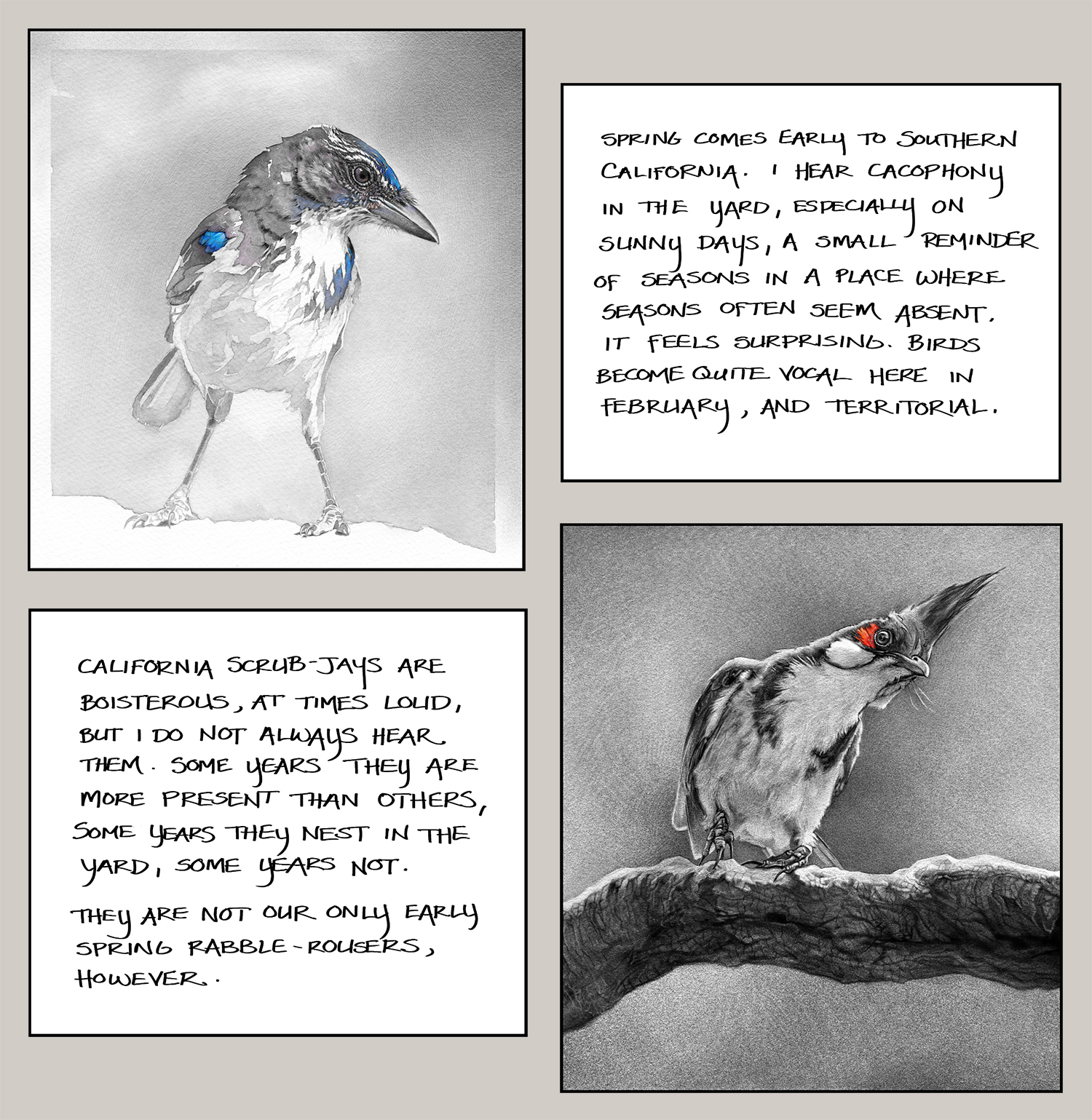
Spring comes early to Southern California. I hear cacophony in the yard, especially on sunny days, a small reminder of seasons in a place where seasons often seem absent. It feels surprising. Birds become quite vocal and territorial here in February, a month I normally associate with gray, and white, and silence. I am accustomed to winter pallor, settled into the landscape and into my sun-deprived skin. I formed my instincts for seasonal change within in the winters of New England, but it is not like that here.
California Scrub-Jays are boisterous, at times loud, but like all corvids they are fiercely intelligent, and they often skulk. Despite being one of our common birds, I do not always hear them. Some years the scrub-jays are more present than others, sometimes they nest in or near our yard, sometimes not. This February they have been circling, calling, and generally making themselves known. I really hope they nest in our yard this spring. Jay families are fun.
California Scrub-Jays are not our only early spring rabble rousers, however. We have a newer nesting species in the yard: Red-whiskered Bulbuls. From their origins as escaped cage songsters, they are garrulous newcomers, and the population currently appears to be under a great explosion and expansion locally. I like to call them burbles, because that is how they sound.
Red-whiskered Bulbuls are generally considered invasive as non-native populations, said to impact both crops and native bird species, but like a lot of preconceptions, it might not be as simple as it seems. A non-native species might be a feral population without being invasive. To meet the criteria for our current U.S. governmental definitions of invasive, a non-native species must cause or have the potential to cause environmental, economic, or human health harm. I have seen older publications about the bulbuls destroying our famed citrus crops, and about the early attempts to destroy the birds. Pasadena citrus crops are now mostly historic (and as an aside, also non-native); those groves fell to housing developments many decades ago. Because of this, I observe our new neighbors and reserve judgment, and wish for more current data and published papers.
I have seen some interesting things. A couple of years ago I witnessed an extraordinary interaction between a California Scrub-Jay and an immature Red-whiskered Bulbul. I watched an epic, drawn-out fight between the two, deep within a non-native shrub, complete with a chorus of adult bulbuls chattering and diving in and out of the fray. Scrub-jays are far more massive than Red-whiskered Bulbuls, with the bulbuls weighing in somewhere between 24-31g, while the scrub-jays run 70–100g. It was not a particularly fair fight, but whether the scrub-jay was showing predatory or territorial or protective behavior, I am not 100% sure. Despite being the smaller of the two, the young bulbul was fierce and hung in there. Then came the most extraordinary part: the scrub-jay pinned the bulbul to the ground, and the bulbul fell still. It was very, very still, rigor mortis-like still, with its legs frozen in the air. The scrub-jay pulled a couple more of the bulbul’s breast feathers off, hopped with them in its bill to the top of the shrub, quite victorious, and then flew away. I was astonished and headed to the house to get a bag to collect the bulbul body, when the bulbul jerked a leg. One leg stretched, then the next, and then the bird flipped over, shook itself off, and joined the other bulbuls, seemingly ok.
Life is complicated. I have theories but do not know the full extent or meanings of the observed altercation and behaviors, but I can guarantee I will be watching closely again this year.
Citations and more information:
– https://www.iucngisd.org/gisd/species.php?sc=1230
– National Invasive Species Information Center
– U.S. DEPARTMENT OF AGRICULTURE https://www.invasivespeciesinfo.gov/what-are-invasive-species
– Islam, K. and R. N. Williams (2020). Red-whiskered Bulbul (Pycnonotus jocosus), version 1.0. In Birds of the World (S. M. Billerman, Editor). Cornell Lab of Ornithology, Ithaca, NY, USA. https://doi.org/10.2173/bow.rewbul.01
– Curry, R. L., A. T. Peterson, T. A. Langen, P. Pyle, and M. A. Patten (2020). California Scrub-Jay (Aphelocoma californica), version 1.0. In Birds of the World (P. G. Rodewald, Editor). Cornell Lab of Ornithology, Ithaca, NY, USA. https://doi.org/10.2173/bow.cowscj1.01
– U.S. Geological Survey https://www.usgs.gov/programs/biological-threats-and-invasivespecies-research-program/science/invasive-species
– https://www.latimes.com/archives/la-xpm-1985-12-29-ga-25787-story.html
About Post Author
Visits on this Page:1583